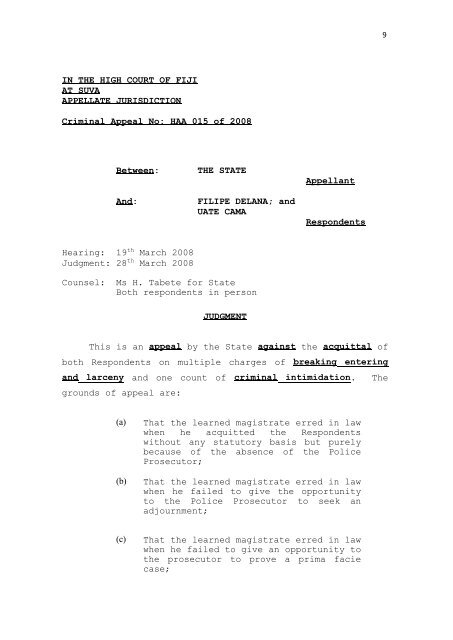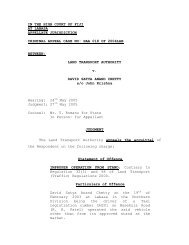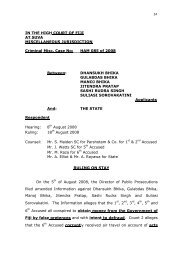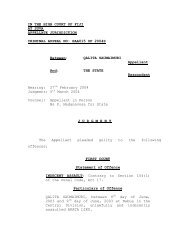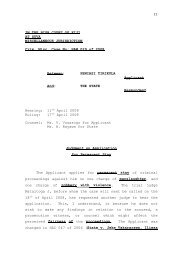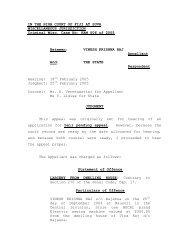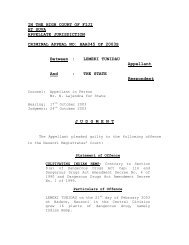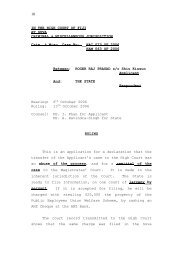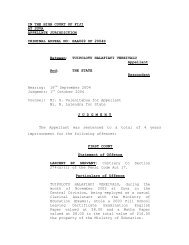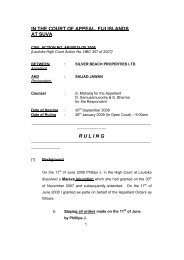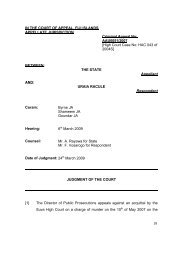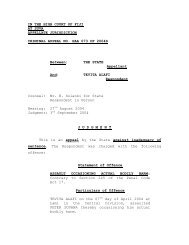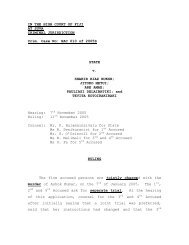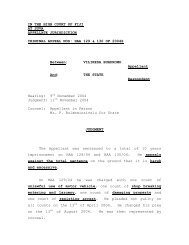State v Filipe Delana and Uate Cama HAA015J.08 - Law Fiji
State v Filipe Delana and Uate Cama HAA015J.08 - Law Fiji
State v Filipe Delana and Uate Cama HAA015J.08 - Law Fiji
You also want an ePaper? Increase the reach of your titles
YUMPU automatically turns print PDFs into web optimized ePapers that Google loves.
(AHS). Conditional on a household making positive maintenance expenditures in a year, theaverage annual amount was just over $1,750 in current dollars. Cameron <strong>and</strong> Tracy (1998) reportthat for the period 1992-96 the average transitory income variance was 8.5 percent, or$2,200.Even with reductions in the fixed costs associated with mortgage refinancings, maintenance <strong>and</strong>improvements spending still should be less costly than housing debt to alter in response to incomeshocks. Moreover, most maintenance can be deferred equally well in rising <strong>and</strong> falling interestrate environments.While not focusing on the role of housing, the D&G study cited above reports someintriguing results regarding this type of spending. Using Consumer Expenditure Survey (CEX)data, they estimate that “home services”, which consists of various repair <strong>and</strong> maintenanceactivities, has an elasticity of 0.60 with respect to income changes. The only larger elasticity wasfor durable goods which has an elasticity of 0.89. 7 The CEX data, then, indicate that homeownersdo save/dissave in their house in responding to income fluctuations.We build on D&G’s approach by examining this question using an alternative data source,the AHS. The AHS data is particularly well suited to an analysis of the role of housing inconsumption smoothing, as it allows us to look at income changes over wider time intervals <strong>and</strong>to control for characteristics of the household, the neighborhood, <strong>and</strong> the local housing marketwhich could influence the estimated elasticities. In addition, we employ a friction regressionmodel that captures the propensity for zero changes in maintenance expenditures (which areprevalent in the data) by assuming that small changes in desired expenditures (whether positive or7 These elasticities are taken from Table 4 of D&G <strong>and</strong> are based on their IV estimates. D&G alsoexamined the PSID data which tracks consumption of food <strong>and</strong> housing expenditures. Housingexpenditures in the PSID data consist of rent <strong>and</strong> mortgage payments. They find that the elasticity ofhousing expenditures in the PSID is significantly lower, ranging from 0.16 to 0.18 (see Table 3).-4-
9complainant does not appear the court maydismiss the charge with or without costs asthe court shall think fit.”This last section contains no power to acquit (<strong>State</strong> v.Semisi Wainiqolo HAA00117/97, Rajendra Ist Deo v. RatneshLal Jattan [2002] HAA 077/02S.)The only section under which the learned Magistratecould have acquitted at the state of the trial that he did,is section 210. It is clear however that he erred forseveral reasons.When the prosecutor failed to appear in court by9.30am, the learned Magistrate was faced with two options.He could have adjourned the case to later in the day toallow the prosecution to call its witnesses on the trialwithin a trial. In deciding whether or not to opt for thiscourse, he should have considered the history of the case.It is clear from the history set out in this judgment thatthe bulk of the adjournments was due to the court’s delay.On a few occasions, both Respondents, or one of them failedto appear. Only one adjournment could be laid at theprosecutor’s door.Further, the adjournment for a trial within a trial wasan unnecessary complication. When the interviewing officerswere called to give evidence, the presiding magistrateshould immediately have asked the Respondents if theyobjected to the admissibility of the statements. Thequestion of voluntariness should not have been allowed toarise willy nilly in the course of cross-examination by theunrepresented defendants. If the questions had been askedof the accused by the court earlier in the day, theprosecution could have conducted a voire dire at the outset.
9In these circumstances, the learned magistrate shouldhave chosen to adjourn. This was a case involving seriousallegations. Much of the evidence had already been led. Itwas obviously in the public interest to allow theprosecution to continue with its case. As the High Court<strong>and</strong> Court of Appeal have said in a number of cases (RobertTweedie Macahill v. R [1980] AAU43/80; <strong>State</strong> v. SamuelaNabainivalu [1997] HAA0039d/97S; Rajesh Ch<strong>and</strong> & ShaileshKumar v. <strong>State</strong> [2001] AAU0056/99S), the decision to adjournis a judicial decision to be made after a balancing of allrelevant factors. In the Rajesh Ch<strong>and</strong> & Shailesh Kumardecision, the <strong>Fiji</strong> Court of Appeal held that although anapplication for an adjournment requires the exercise of ajudicial discretion with which an appellate court willrarely interfere, it will be reviewed on appeal where the“result of the order is to defeat the rights of the partiesaltogether or to do an injustice to one or other party.”In DPP v. Neumi Kalou & Anor. (1996) 42 FLR 126, it washeld that in the exercise of the discretion, the magistrateor judge should consider not only the interests of theaccused person, but also the overall interests of justice.This is particularly so when the charge is serious <strong>and</strong> thereis a strong public interest in ensuring that such chargesare properly tried.The court record for the 29 th of October 2007 does notdisclose the exercise of any such discretion. Indeed thelearned magistrate appears to have assumed that his onlyoption was to consider whether there was sufficient evidenceto put the accused to their defence. He found there wasnot. In making such a finding he fell into further error.
9The test at the end of the prosecution case is whether,when taken at its highest, the evidence is such that areasonable tribunal might convict on it (Afasio Mua & Othersv. <strong>State</strong> (1991) 37 FLR 27, Shell <strong>Fiji</strong> Limited, Mobil Oil(Aust) Ltd. v. <strong>State</strong> [2002] HAA001/00L.If, having properly <strong>and</strong> judicially considered that hewould not adjourn to wait for the prosecutor, the learnedmagistrate decided to consider whether there was a case toanswer, he should have applied this test to the evidence.The evidence led implicated the 1 st Respondent directly evenwithout his police confession. There was clearly a case toanswer on each charge for the 1 st Respondent who had beenidentified as the person holding a knife to the head of PW1,restraining him <strong>and</strong> taping his mouth for the whole period ofthe breakins. The 1 st Respondent should have been put tohis defence on this evidence alone.There was no evidence implicating the 2 nd Respondentother than his statement to the police. In that statementhe said that he was a hairdresser working at the Yatu LauArcade <strong>and</strong> that it was he who counseled the others to stealfrom the shops in the Arcade. He said he did not accompanythe others on the night of the breakins. If the learnedmagistrate had refused any adjournment after properconsideration, he would have been correct to find that therewas no case against the 2 nd Respondent. This is because the2 nd Respondent disputed the admissibility of his policestatement <strong>and</strong> it was the prosecution’s responsibility toprove voluntariness <strong>and</strong> admissibility.In the circumstances of this case, the multiplecharges, the history of court adjournments, the lack of
9fault on the part of the prosecution, the public interest inensuring that a trial took place <strong>and</strong> the fact that the trialhad only been adjourned because the objection toadmissibility had been raised at a late stage, the learnedmagistrate should have stood the matter down to allow theprosecutor to call his/her evidence <strong>and</strong> to close the case.In failing to do so, an injustice has occurred to theprosecution.The acquittal must be quashed <strong>and</strong> the case remitted tothe same magistrate to continue with the trial.ResultThis appeal succeeds. The acquittals of bothRespondents are quashed. The trial is to continue beforethe same magistrate.At Suva28 th March 2008Nazhat ShameemJUDGE


